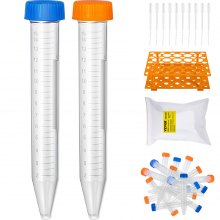












Centrifuge tubes store liquids throughout the centrifugation process, rapidly rotating the sample along a fixed axis to separate its constituent parts. Conical bottoms on most centrifuge tubes aid in gathering any heavier or more solid components of the sample undergoing centrifuging.
VEVOR Centrifuge Tubes are the pinnacle of innovative technology when it comes to scientific advancements, providing researchers with an unmatched window into the realm of exact testing.
Designed explicitly for centrifugation, centrifuge tubes differ from ordinary test tubes. Utilize centrifuge tubes to divide a compound into its constituent parts. A few fields that make use of centrifuge tubes are listed below.
For soil analysis, numerous extraction techniques call for mixing soil with a solvent or water. The target analytes can be released from the soil to the water by thoroughly mixing the soil and water, allowing for instrument analysis.
When soil and water are combined, the mixture is frequently too muddy and contains too many big soil particles for accurate analysis. All soil material will be drawn to the tube's bottom by centrifuging the sample. After that, the water in the tube can be taken out for examination.
Specific lab equipment is susceptible to impurities. Extraneous items that find their way into high-pressure chromatography equipment and mass spectrometers might cause blockages.
Small material samples are injected through columns to operate these instruments. After the samples and analytes are separated, specialist software is used to examine the samples. Centrifuge tubes are essential to avoid clogged laboratory instruments.
In medical laboratories, centrifuge tubes are essential for separating components. They can isolate the organelles from the cell and observe how viruses and cells settle in blood samples. A crucial step in removing DNA or RNA from a cell is centrifugation.
Water is combined with other materials in procedures used by customers in businesses such as the chemical and pharmaceutical industries. They may have included fuel, oil, or other impurities in the sample they submitted for examination.
The sample needs to be centrifuged by the analyzer to examine the water. The water and other impurities will become separated as a result. Afterward, the analyst can remove the materials and use a pipette or syringe to collect the water.
Due to the extreme spinning speeds that centrifuge tubes must withstand, they are subjected to enormous pressure. Their rotational velocities range from 500 to 1500 rpm! Achieving high spinning speeds requires the centrifuge to be balanced.
If the samples are uniformly spaced, the bowl may stay balanced. This may result in the centrifuge toppling over, the centrifuge tubes flying out, or possibly the centrifuge breaking in two.
Keeping extra centrifuge tubes on your fingertips and filling them with water to match the tubes' sample amount is an easy way to solve the problem.
To guarantee a safe and efficient rotation, the weight must be divided equally among the vials, and each vial must have the same volume. The centrifuge may be repeatedly balanced using those vials filled with water.
A lot of considerations need to be made when buying centrifuge tubes. You must determine the most important tube characteristics, as different tubes operate differently. Here are some things to think about while selecting your centrifuge tubes.
The choice of material used to make a tube significantly impacts its chemical resistance. It is imperative to consider the type of chemicals you are handling and confirm that the tube can withstand the substance.
Polypropylene (PP) is so popular because it is immune to many organic solvents and can withstand high speeds. Even so, verifying the resistance of your PP tubes before using them is beneficial.
Given how much easier it is to clean glass after use, it might be preferable to ensure you're working with sterile tubes. Sterilizing plastic is more complex than cleaning it.
Another safer option for holding corrosive metals is glass. Centrifuge tubes made of glass are uncommon. Glass has drawbacks compared to plastic, although it can withstand higher temperatures better.
Plastic is less expensive and more robust. Additionally, glass tubes small enough for microcentrifuges are not readily available.
The amount you'll need to fill the centrifuge tubes is the last item to consider before buying them. A centrifuge tube is often only filled three-fourths of the way. Leaking can occur when a tube is overfilled.
Except for ultracentrifuge tubes. The tubes in these centrifuges must be filled to prevent them from collapsing because they spin at extremely high speeds. The manufacturer's specs are the greatest source of information about the volume required for your tube.
VEVOR Centrifuge Tubes are the pinnacle of scientific quality; use them to up your research game. These tubes, which are precisely crafted and innovatively built, are redefining norms in the laboratory.
VEVOR Centrifuge Tubes are designed with state-of-the-art technology to guarantee the best possible sample integrity and repeatability. Discover smooth centrifugation, where each spin brings you one step closer to being a scientific genius.
You may rely on VEVOR to combine performance, quality, and the goal of expanding the frontiers of study. Select VEVOR Centrifuge Tubes because nothing less than the best will do for your investigations.
There are many sizes of centrifuge tubes: microcentrifuge tubes have a capacity of a few milliliters, while bigger tubes have a capacity of more than fifty milliliters. The sample volume and the centrifuge's characteristics determine the selected size.
Indeed, centrifuge tubes are helpful in various clinical and research contexts. They are employed in multiple scientific procedures, including blood separation and cell culture.
Specific tubes are meant to be used only once, whereas others can be autoclaved and used again. To determine if and under what circumstances the tubes can be reused, consult the manufacturer's requirements.